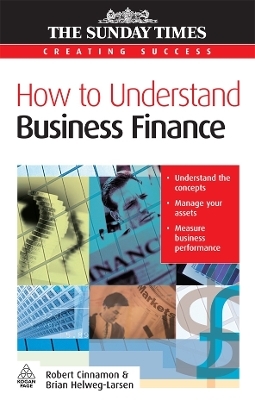
How to Understand Business Finance
Kogan Page Ltd (Verlag)
978-0-7494-4668-0 (ISBN)
- Titel erscheint in neuer Auflage
- Artikel merken
"Explains accounting to the self-employed and small firms." - Observer
"The book is based on a highly visual and participative training event that brings the subject to life..." - Accountancy Age
The modern marketplace is increasingly unpredictable and there is an ever-greater need for non-financial managers to understand the financial and management accounting process.
How to Understand Business Finance is not written by an accountant and actually relates to running a business in a real market. It provides a quick and effective course from the perspective of the pursuit of business growth, and describes a business proceeding from initial set-up through its first year of trading.
As well as learning how to understand the balance sheet and profit and loss account, readers will also grasp the principles of: market dynamics; budgeting and forecasting; fixed and variable costs; break-even analysis; the difference between profit and cash; financial ratios for measuring business performance; investment appraisal; stock market ratios; shareholder value; financial measures for improving business performance, and much more.
Robert Cinnamon is an educator with a global reputation. As a director of the international training and consultancy firm, INSIGHT Marketing and People, he runs his popular masterclass and in-company training programme Demystifying Financial Management. Brian Helweg-Larsen is a global educator and director of Profitability Business Solutions. He teaches in three languages across five continents and runs the only business simulation used by the Harvard Business School's MBA Programme.
1so why do you want to know more about finance? learning; a tale of two languages 2the business cycle setting up a company; the moving balance sheet(r); creating value; cash and profit; setting up and running the business - the opening month; profit and loss (p&l) account; the balance sheet; month 2 business cycle; going to the bank; doing the books 3the books and double-entry bookkeeping reports; double-entry bookkeeping; taxation 4where do all the business functions fit in? sales; marketing; manufacturing; supply chain management; human resources; it, maintenance and engineering; research and development; finance 5financial planning - the budgets budgeting; cash flow forecast; avoiding bankruptcy; how to generate cash 6measuring business performance: financial ratios size; p&l account (income statement) analysis; balance sheet analysis 7how our investors see us - stock market ratios what accounts do our investors want to see?; shares 8valuing a company asset value; multipliers; market capitalisation; balanced scorecard; cash flows 9shareholder value and economic profit earnings before interest, tax, depreciation and amortisation (ebitda); economic profit; total shareholder return (tsr) 10the hidden costs - depreciation and amortisation depreciation; goodwill; intangible assets; capitalising costs 11what must we sell to make a profit? variable costs; fixed costs; break-even point 12tools for evaluating projects payback; discounted cash flow (dcf); net present value (npv); internal rate of return (irr); terminal values; economic profit; pitfalls; other factors 13where is all our cash? managing working capital stock (inventories); debtors; creditors; write-offs; cash flow implications of working capital 14next steps... training; contact details 15glossary of financial terms
| Erscheint lt. Verlag | 3.5.2006 |
|---|---|
| Reihe/Serie | Creating Success |
| Verlagsort | London |
| Sprache | englisch |
| Maße | 135 x 216 mm |
| Themenwelt | Wirtschaft ► Betriebswirtschaft / Management ► Finanzierung |
| ISBN-10 | 0-7494-4668-4 / 0749446684 |
| ISBN-13 | 978-0-7494-4668-0 / 9780749446680 |
| Zustand | Neuware |
| Informationen gemäß Produktsicherheitsverordnung (GPSR) | |
| Haben Sie eine Frage zum Produkt? |
aus dem Bereich



